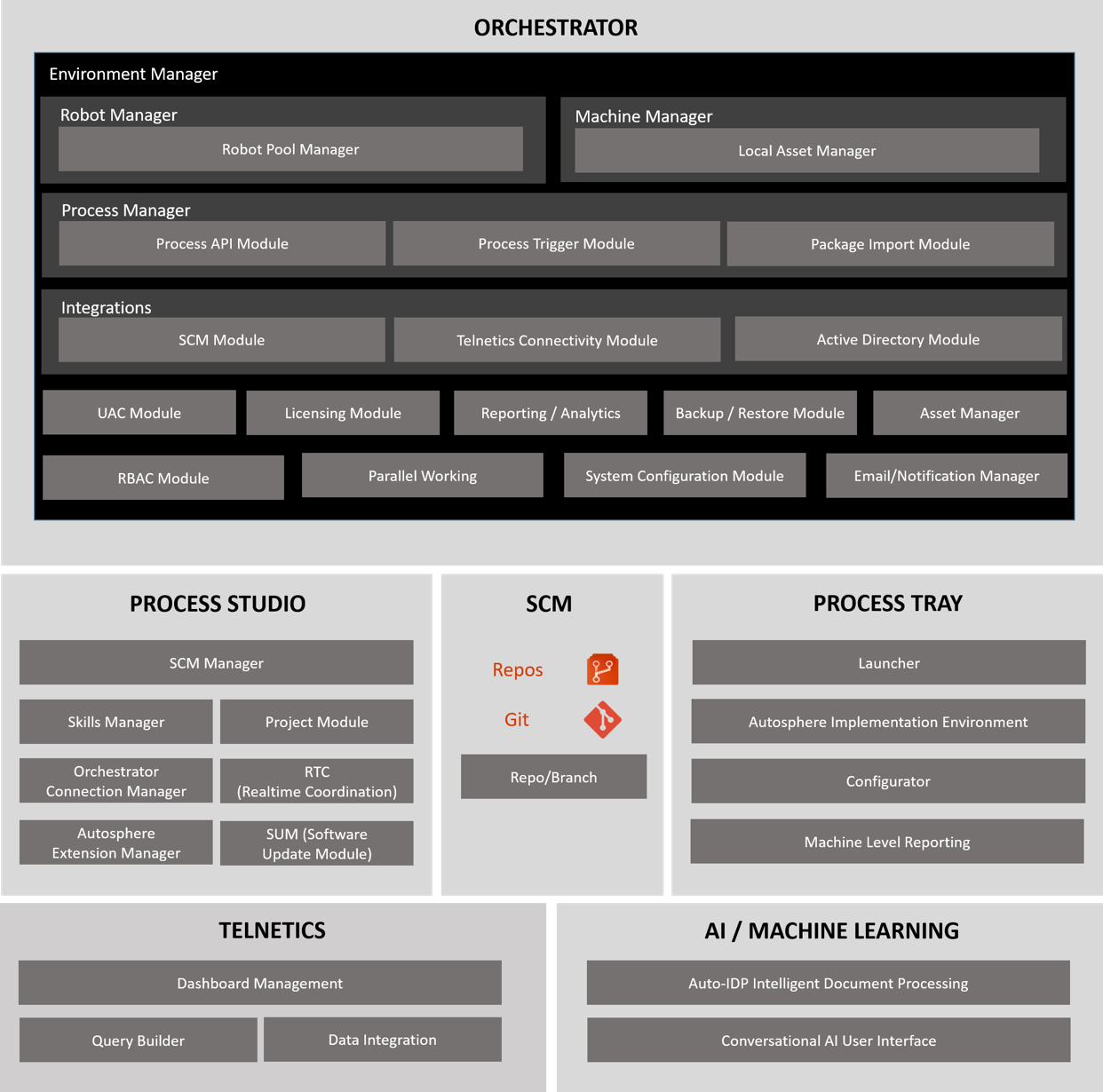Autosphere iRPA platform overview
Autosphere is an enterprise-grade iRPA platform used to design, deploy, and monitor RPA bots. It lets you create software-based robots to emulate human interaction with systems, to run tasks and processes with more accuracy and efficiency. These robots can capture data and manipulate applications just as humans do. Autosphere is non-intrusive in nature, which means it allows systems to integrate quickly without causing disruptions. You can use Autosphere to automate processes that are high volume, manual, and repetitive. Autosphere can initiate processes in the background and/or in parallel. Unlike other platforms, it provides support on multiple operating systems. The platform drives collaboration between developers, business analysts, and other stakeholders.

High level functional architecture
Autosphere Process
Studio
Modules within
Process
Studio
Real Time Control (RTC) supports near real-time sync, which enables
users to see all the changes in their workspace in near real-time.
Autosphere Process Studio is a modular, extension-based environment.
The extension manager is responsible for managing all the
extensions, including
Recorder,
Scraper, Element Locator, and Keyword Explorer
Automation control, monitoring, and tracking
Autosphere
Orchestrator
-
Orchestrator tracks and logs everything each robot and human does to ensure compliance and security. Orchestrator provides easy access to enterprise automation. Orchestrator has many modules working together to manage all the environments, including robots, users, processes, and permissions.
-
Environment Manager manages the creation, deletion and segregation of these different environments. All the components of the Orchestrator reside within the Environment Manager's jurisdiction. The four major components within this environment are Robot Manager, Process Manager, Machine Manager, and Integrations.
-
Robot Manager is responsible for managing robot creation, deletion, and allocating resource pool groups to robots.
-
Machine Manager enables the creation of usable assets for development at a local level.
-
Process Manager is responsible for managing process operations, managing APIs against every process, and automation package import.
-
Integration modules allow Autosphere to integrate with SCM, Telnetics Data Streams
, and Active Directory for user access control (UAC).
These four major components work with all the remaining components within the Environment Manager to carry out their tasks efficiently. The remaining components are:
-
The User Access Control (UAC) module controls the different access permissions defined under the role.
-
The Licensing module controls the assignment and validation of licenses generated by Autosphere. It also controls reporting and analytics at robot, process, job, and machine level.
-
The Backup and Restore module periodically creates backup snapshots of all the data generated by Autosphere at scheduled instance.
-
The Asset Manager manages encrypted secure information and creates usable asset for development process.
-
The Email/Notification manager module generates notifications and emails based on different alert within platform.
-
The role-based access control (RBAC) module lets you define different roles and permissions which could be assigned to certain user group.
-
The Parallel Working module invokes multiple bots at runtime to handle a process with a high number of transactions. It enables the bots to divide the workload and perform tasks in parallel mode.
-
The System Configuration module is used to configure global settings for orchestrator.
-
Need-based multi-purpose bots
Autosphere focuses on software-based robots that can learn, mimic, and then complete human interactions in rule-based business processes. Autosphere offers the following three distinctive bots:
-
Superbot — Superbot Attended
is ideal for use cases where humans work in collaboration with robots, whereas Superbot Unattended is best for use cases that require no human intervention. -
Multitasking bot — Along with additional features, a multitasking bot is capable of doing everything that a superbot can do. It can also invoke multiple bots at runtime to handle a process with high transactions. It enables the bots to divide the workload and complete tasks in parallel mode.
-
Monitoring bot — Monitoring bots are used on interfaces which require constant monitoring and are dedicated on business-critical interfaces.
The process tray contains different modules to maintain efficiency of these different bots, including Superbot, Multitasking bot, and Monitoring bot. The Process Launcher allows running process from the robot machine (Attended). The Autosphere Implementation environment consists of the core Autosphere engine, automation packages, and dependencies. Configuration is required for connectivity of the bot with the Orchestrator instance. Machine-level reporting is important for the performance monitoring of jobs run on the specific machine.
Integrate data streams, configure metrics, and visualize ROI
Autosphere bring focus on automation visibility with the help of
its extension,
Telnetics
-
Dashboard Management enables the creation and management of multiple dashboards based on environments, robots, and processes.
-
The Data Integration module allows for the integration of data streams from third-party tools, Orchestrator, and Process Studio.
-
Query Builder allows building queries for metrics on dashboards.
Artificial intelligence (AI) and machine learning (ML)
Autosphere uses
AutoIDP
Human-in-the-Loop
Integration of Autosphere Platform with AWS services
Autosphere Platform

High-level functional architecture with AWS services